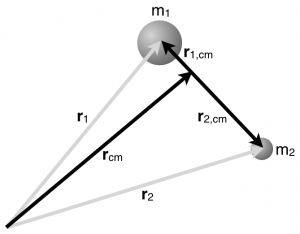This is an old revision of the document!
Formal derivation of $K_{trans}$ and $K_{rel}$
In the notes, you will read about the formal derivation to separate the total kinetic energy into a translational component that tracks the energy associated with the motion of the center of mass, and the relative component that that tracks the energy of due to the motion relative to the center of mass.
Locating objects relative to the center of mass
Begin by considering two particles, one of mass $m_1$ at location $\vec{r}_1$ measured relative to some fixed coordinate axes and the other of mass $m_2$ at location $\vec{r}_2$ measured relative to the same coordinate axes. Both of these vectors positions are indicated with grey arrows.
For these two particles, we could determine their center of mass,
$$\vec{r}_{cm} = \dfrac{m_1\,\vec{r}_1 + m_2\,\vec{r}_2}{m_1+m_2}$$
which is indicated by a black arrow, and then measure their positions relative to the center of mass ($\vec{r}_{1,cm}$ and $\vec{r}_{2,cm}$, also black arrows in the figure). The location of each particle can be related to these vectors,
$$\vec{r}_1 = \vec{r}_{cm} + \vec{r}_{1,cm} \qquad \vec{r}_2 = \vec{r}_{cm} + \vec{r}_{2,cm}$$
So in general you could have a collection of many particles each with a location vector given by,
$$\vec{r}_i = \vec{r}_{cm} + \vec{r}_{i,cm}$$
Total Kinetic Energy of a System of Particles
If you had a system of many particles, you could compute the total kinetic energy of the system by adding up the kinetic energy of each particle.
$$K_{tot} = \dfrac{1}{2}m_1\,v_1^2 + \dfrac{1}{2}m_2\,v_2^2 + \dfrac{1}{2}m_3\,v_3^2 + \dots$$
where the kinetic energy of the i-th particle is given by,
$$K_i = \dfrac{1}{2}m_i\,v_i^2$$
This kinetic energy is can be written in terms of the rate of change of the displacement of the particle,
$$K_i = \dfrac{1}{2}m_i\,\left[\dfrac{d\vec{r}_i}{dt}\right]^2$$ $$K_i = \dfrac{1}{2}m_i\,\left[\dfrac{d}{dt}\left(\vec{r}_{cm} + \vec{r}_{i,cm}\right)\right]^2 $$ $$K_i = \dfrac{1}{2}m_i\,\left[\dfrac{d\vec{r}_{cm}}{dt} + \dfrac{d\vec{r}_{i,cm}}{dt}\right]^2 $$ $$K_i = \dfrac{1}{2}m_i\,\left[\vec{v}_{cm} + \vec{v}_{i,cm}\right]^2 $$
where the last steps take into account the location with respect to the center of mass and result in separating the velocity of the particle into the sum of the velocity of the center of mass, and the velocity of the particle relative to the center of mass. This expression can be multiplied out using the dot product to find,
$$K_i = \dfrac{1}{2}m_i\,\left[\vec{v}_{cm}\cdot\vec{v}_{cm} + 2\vec{v}_{cm}\cdot\vec{v}_{i,cm} + \vec{v}_{i,cm}\cdot\vec{v}_{i,cm}\right] $$ $$K_i = \dfrac{1}{2}m_i\,\vec{v}_{cm}\cdot\vec{v}_{cm} + m_i\,\vec{v}_{cm}\cdot\vec{v}_{i,cm} + \dfrac{1}{2}m_i\,\vec{v}_{i,cm}\cdot\vec{v}_{i,cm}$$
And thus, the total kinetic energy is given by,
$$K_{tot} = \sum_i K_i = \sum_i \dfrac{1}{2}m_i\,\vec{v}_{cm}\cdot\vec{v}_{cm} + \sum_i m_i\,\vec{v}_{cm}\cdot\vec{v}_{i,cm} + \sum_i \dfrac{1}{2}m_i\,\vec{v}_{i,cm}\cdot\vec{v}_{i,cm}$$
